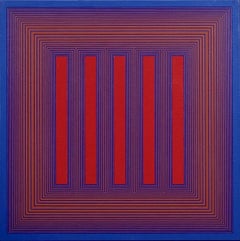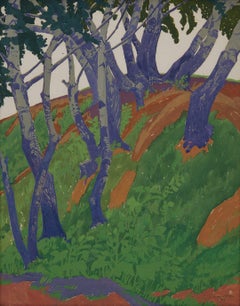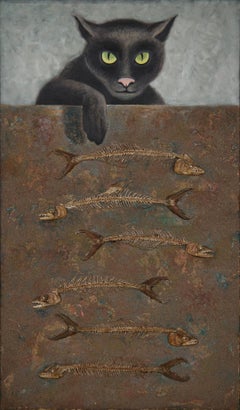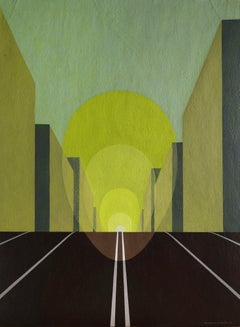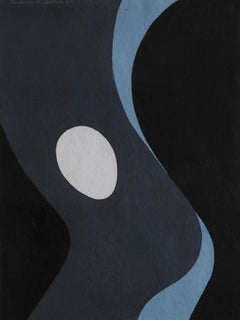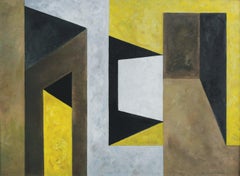WOLFS
to
5
338
156
97
57
51
49
39
34
30
27
25
22
15
15
11
10
8
7
7
7
5
4
4
3
2
2
2
1
1
59
49
31
15
13
Temple of Evening Reds, 1983 Acrylic OpArt by Cleveland School Artist
By Richard Anuszkiewicz
Located in Beachwood, OH
Richard Anuszkiewicz (American, 1930-2020)
Temple of Evening Reds, 1983
Acrylic on canvas
Signed verso
36 x 36 inches
36.75 x 36.75 inches, framed
Richard Anuszkiewicz was born in E...
Category
1980s Op Art Abstract Paintings
Materials
Acrylic
Hillside and Stream, early 20th century modernist Cleveland School painting
Located in Beachwood, OH
Clara Deike (American, 1881-1964)
Hillside and Stream, 1916
Gouache on paper
Signed and dated lower right
22 x 18 inches
25.5 x 21.5 inches, framed
A graduate of the Cleveland Schoo...
Category
1910s American Modern Figurative Paintings
Materials
Gouache
Over and Above: No. 6, Surreal Cat w/ Fish Bones, 20th Century Cleveland School
By Clarence Holbrook Carter
Located in Beachwood, OH
Clarence Holbrook Carter (American, 1904–2000)
Over and Above: No. 6, 1963
Oil, sand & fish bones on canvas
Signed and dated upper left
53 x 31 inches
Clarence Holbrook Carter achie...
Category
1960s American Modern Animal Paintings
Materials
Oil
City Scape, Ovoid Geometrical Abstract Green & Brown Structures
By Clarence Holbrook Carter
Located in Beachwood, OH
Clarence Holbrook Carter (American, 1904-2000)
City Scape, 1978
Acrylic on scintilla
Signed and dated lower right
30 x 22 inches
A surrealist mid-century figural abstract painting....
Category
1970s American Modern Figurative Paintings
Materials
Acrylic
Torso No. 1, Mid-Century Figural Abstract Acrylic Painting
By Clarence Holbrook Carter
Located in Beachwood, OH
Clarence Holbrook Carter (American, 1904-2000)
Torso No. 1, 1967
Acrylic on paper
Signed and dated upper right
15 x10 inches
24 x 20 inches, framed
A mid-century figural abstract painting.
Clarence Holbrook Carter achieved a level of national artistic success that was nearly unprecedented among Cleveland School artists of his day, with representation by major New York dealers...
Category
1960s American Modern Abstract Paintings
Materials
Acrylic
In and Out, mid-century figural abstract vibrant yellow geometric painting
By Clarence Holbrook Carter
Located in Beachwood, OH
Clarence Holbrook Carter (American, 1904-2000)
In and Out, 1963
Acrylic on paper
Signed and dated lower right
22 x 30 inches
Figural abstract vibrant yellow geometric painting.
Cl...
Category
1960s Abstract Abstract Paintings
Materials
Acrylic
Muse of Dance, Early 20th century French bronze sculpture of woman
Located in Beachwood, OH
Louis Armand Bardery (French, 1879-1952)
Muse of Dance
Bronze with green and brown patination
Signed and stamped with foundry mark
18 x 6 inches
Louis Armand Bardery was a student o...
Category
Early 20th Century Figurative Sculptures
Materials
Bronze
Night Garden, mid-century figural surrealist acrylic painting, Cleveland School
By Clarence Holbrook Carter
Located in Beachwood, OH
Clarence Holbrook Carter (American, 1904-2000)
Night Garden, 1972
Acrylic on scintilla
Signed and dated lower right
21.5 x 21.5 inches
24.25 x 24.25 inches, framed
Clarence Holbroo...
Category
1970s American Modern Figurative Paintings
Materials
Acrylic
The Luxembourg Gardens, Paris, Early 20th Century Impressionist Landscape
By Abel Warshawsky
Located in Beachwood, OH
Abel Warshawsky (American, 1883-1962)
The Luxembourg Gardens, Paris, 1909
Oil on panel
Signed and dated lower right, titled verso
8.5 x 10.5 inches
13.75 x 16 inches, framed
Impressionist painter A.G. Warshawsky was active in Cleveland, Paris and Monterey, California. Although Warshawsky is known as a classic Impressionist, he is also known for using a realistic style in his portraiture.
Warshawsky was born in 1883 in Sharon, Pennsylvania to Ezekial and Ida Warshawsky, Jewish immigrants from Poland. The family then moved to Cleveland, Ohio. His brother Alexander (Xander) also became an accomplished painter in his own right.
Warshawsky graduated from the Cleveland School of Art in 1900, taught by Louis Rorimer...
Category
Early 1900s Impressionist Figurative Paintings
Materials
Oil
Horses & Trees, 20th Century Landscape Scene, Female Cleveland School Artist
Located in Beachwood, OH
Algesa O'Sickey (American, 1917-2006)
Horses and Trees
Watercolor on paper
Signed lower right
22 x 29.75 inches
25.25 x 33.25 inches, framed
Born Algesa D’Agostino on June 4, 1917, ...
Category
20th Century Landscape Drawings and Watercolors
Materials
Watercolor
Horse Show Preparations, 20th Century Farm Landscape, Cleveland Female Artist
Located in Beachwood, OH
Algesa O'Sickey (American, 1917-2006)
Horse Show Preparations
Watercolor and graphite on paper
Unsigned
18 x 24 inches
23.25 x 29 inches, framed
Born Algesa D’Agostino on June 4, 1...
Category
20th Century Animal Drawings and Watercolors
Materials
Graphite, Watercolor
Two Wagons, Bucks County, PA 20th Century Farm Landscape
By Louis Bosa
Located in Beachwood, OH
Louis Bosa (American, 1905–1981)
Two Wagons, Bucks County, PA, 1934
Oil on canvas
Signed and dated lower right
20 x 24 inches
30 x 34 inches, framed
Born in Codroipo, a small villag...
Category
1930s Expressionist Figurative Paintings
Materials
Oil
$1,400 Sale Price
68% Off
20th Century Spanish Seaside Village (Cadaques Catalonia), Cleveland School
By Rolf Stoll
Located in Beachwood, OH
Rolf Stoll (American, 1892-1978)
Spanish Seaside Village (Cadaques Catalonia)
Oil on canvas
Signed lower right
28 x 38 inches
Exhibited: The 11th Annual May Show, Cleveland Museum of Art, 1929
Rolf Stoll, a painter of figure subjects, landscapes and floral still lifes, was an important member of the Cleveland art scene during the second quarter of the century. He was also an influential teacher, as well as one of Ohio’s foremost portrait painters.
Rolf Stoll was born in Heidelberg, Germany, in 1892. As a boy, he attended a military academy, during which time he developed an interest in art. He received his early formal training at the Academy of Fine Arts in Karlsruhe and at the Academy of Fine Arts in Stuttgart. He emigrated to the United States in 1912, settling in New York City. A decade later, after studying at the school of the National Academy of Design and supporting himself by working as a commercial artist, Stoll decided to leave New York. Upon the recommendation of Warren Pryor, one of his teachers, he decided to move to Cleveland, Ohio. After arriving in Cleveland, Rolf Stoll continued to work as a commercial artist. However, in 1926, he joined the faculty of the Cleveland School of Art, where he taught drawing. Two years later Stoll was appointed head of the school’s portrait painting department. A talented portraitist, Stoll’s sitters included industrialists, community leaders and many prominent members of Cleveland and Ohio society, as well as over twenty faculty members from Case Western Reserve University. Stoll also gave portrait classes at the John Huntington Polytechnic Institute from 1926 to 1953. In his male portraits especially, he was admired for his ability to convey the dignity of his sitter’s professional position without sacrificing individuality. As noted by one contemporary reviewer, Stoll was a “master of rich color, a searching student of human types, a forceful portrayer of all that the face reveals of the mind and the soul.” In addition to his activity as a portraitist, Rolf Stoll painted figure subjects and floral still lifes. He was also known for his views of the Ohio countryside and Canada. Stoll also painted views of Spain and depictions of Spanish peasants, inspired by an extended trip to that country (1926), during which time he was entertained by the famous Spanish portrait painter, Ignacio Zuloaga. Moving easily between oil and watercolor, Stoll worked in an direct realist style, combining his characteristic firm draftsmanship with the use of simplified forms and decorative color.
Rolph Stoll was a member of the Cleveland Society of Artists, the Cleveland Print Club...
Category
1920s Landscape Paintings
Materials
Oil
Portrait of a Startled Woman, 20th Century Monumental Oil Painting
Located in Beachwood, OH
Robert Brooks (American, 1922-1992)
Portait of a Startled Woman
Monumental oil on canvas
Signed lower right
80 x 42 inches
Born in Fall River, Massachusetts in 1922, Robert Brooks embarked on his art career by winning modeling clay as a reward for good attendance at primary school. He became known for embellishing the margins of his school books with sketches of his friends and maybe teachers. He operated his own sign making business as a teenager, which supplied little money but lots of experience. Brooks also entered every poster and drawing competition in sight. Saturday morning classes at the Swain School of Design provided him with sound instructions in the principles of art, and as a high school senior in 1941, Brooks was awarded a scholarship to Boston's Vesper George School of art in a annual state-wide competition. During this year in Boston, he specialized in design, color and the theater arts and discovered "watercolor" as his favorite medium. At the end of his year Brooks was awarded a scholarship to continue by the Vesper George School but returned to New Bedford before the second year was out in order to work in the design department of a large textile printing concern.
He was called to serve his country and after basic training, casual detachments and port of embarkation, he made his own private beachhead on New Caledonia in 1943, where he served as staff artist for The South Pacific Daily News. Brooks painted sketches and watercolors of the local scene during his daytime off-duty hours and won fast acclaim for his crisp, clean paintings...
Category
20th Century Figurative Paintings
Materials
Oil
Pantheum Moonlight, Early 20th century surrealist landscape, Cleveland School
By Ferdinand Burgdorff
Located in Beachwood, OH
Ferdinand Burgdorff (American, 1881-1975)
Pantheum Moonlight, 1916
Oil on canvas
Signed and dated lower right
16 x 24 inches
21.5 x 29.5 inches, framed
Born in Cleveland, Ohio, Ferd...
Category
1910s Surrealist Figurative Paintings
Materials
Oil
Villa Giardino, 20th Century Charcoal Italian Landscape Drawing
Located in Beachwood, OH
Clara Deike (American, 1881-1964)
Villa Giardino
Charcoal on paper
Signed and titled verso
17.75 x 12.5 inches
A graduate of the Cleveland School of Art in 1912, Clara Deike was pa...
Category
20th Century American Modern Figurative Drawings and Watercolors
Materials
Charcoal
Standing Nude Man, Mid-Century Figural Expressionist Painting, New York Artist
By Joseph Glasco
Located in Beachwood, OH
Joseph Glasco (American, 1925-1996)
Standing Man, 1955
India ink and gouache on textured paper
10 x 8 inches
16.75 x 13.5 inches, framed
Joseph Glasco was born in Paul’s Valley, Okl...
Category
1950s Abstract Expressionist Figurative Paintings
Materials
India Ink, Gouache
Cathedral in Venice, large 20th century oil painting, Italian-American artist
By Louis Bosa
Located in Beachwood, OH
Louis Bosa (American, 1905-1981)
Cathedral in Venice
Oil on canvas
Signed lower left
60.25 x 40.25 inches
66.5 x 46.5 inches, framed
Born in Codroipo, a small village only a few mi...
Category
Mid-20th Century Expressionist Figurative Paintings
Materials
Oil
Ovoid, geometrical figural surrealist acrylic painting, Cleveland School artist
By Clarence Holbrook Carter
Located in Beachwood, OH
Clarence Holbrook Carter (American, 1904-2000)
Ovoid, 1992
Acrylic on canvas
Signed and dated lower right
7.75 x 7.75 inches
9 x 9 inches, framed
Clarence Holbrook Carter achieved a...
Category
1990s American Modern Abstract Paintings
Materials
Acrylic
Propagation-L, mid century figurative abstract screenprint, 20th century artist
By Takesada Matsutani
Located in Beachwood, OH
Takesada Matsutani (Japanese, b. 1937)
Propagation-L, 1971
Screenprint in colors
Edition 51/75
28 x 27 inches
28.25 x 27.25 inches, framed
Takesada Matsutani is a Japanese avant-ga...
Category
1970s Modern Abstract Prints
Materials
Screen
Fiesta, c. 1973, red, yellow & blue figurative abstract lithograph
By Alexander Calder
Located in Beachwood, OH
Alexander Calder (American, 1898-1976)
Fiesta, c. 1973
Lithograph in colors
Signed lower right
Edition: E. A.
20 x 28 inches
35.5 x 37.75 inches, framed
One of America's best known ...
Category
1970s Modern Abstract Prints
Materials
Lithograph
1930 French Bronze Figure of a Lurcher Dog on Stone Base
Located in Beachwood, OH
Jules Edmond Masson (French, 1871–1932)
Bronze Figure of a Lurcher Dog, 1930
Bronze with brownish green patination, on a fitted stone base
The base inset with a bronze plaque reading...
Category
1930s Figurative Sculptures
Materials
Stone, Bronze
Fisherman's Island, Boothbay, Maine, early 20th century landscape watercolor
By Frank Wilcox
Located in Beachwood, OH
Frank Nelson Wilcox (American, 1887-1964)
Fisherman's Island, Boothbay, Maine, c. 1925
Watercolor on paper
Signed lower left
15 x 20 inches
20.75 x 25.75 inches, framed
Frank Nelson Wilcox (October 3, 1887 – April 17, 1964) was a modernist American artist and a master of watercolor. Wilcox is described as the "Dean of Cleveland School painters," though some sources give this appellation to Henry Keller or Frederick Gottwald. Wilcox was born on October 3, 1887 to Frank Nelson Wilcox, Sr. and Jessie Fremont Snow Wilcox at 61 Linwood Street in Cleveland, Ohio. His father, a prominent lawyer, died at home in 1904 shortly before Wilcox' 17th birthday. His brother, lawyer and publisher Owen N. Wilcox, was president of the Gates Legal Publishing Company or The Gates Press. His sister Ruth Wilcox...
Category
1920s American Modern Figurative Drawings and Watercolors
Materials
Watercolor
Early 20th Century Summer Landscape, Cleveland School Artist
By George Adomeit
Located in Beachwood, OH
George Gustav Adomeit (American, 1879-1967)
Summer Landscape
Oil on canvas board
Signed lower right
13 x 14.25 inches
18.25 x 19.5 inches, framed
A major painter of American scene s...
Category
Early 20th Century American Modern Figurative Paintings
Materials
Oil
Nude Walking, Early 20th Century Bronze Sculpture, Cleveland School Artist
By Max Kalish
Located in Beachwood, OH
Max Kalish (American, 1891-1945)
Nude Walking, 1930
Bronze
Signed and dated on base
17 x 9 x 4 inches
Born in Poland March 1, 1891, figurative sculptor Max Kalish came to the United States in 1894, his family settling in Ohio. A talented youth, Kalish enrolled at the Cleveland Institute of Art as a fifteen-year-old, receiving a first-place award for modeling the figure during studies with Herman Matzen. Kalish went to New York City following graduation, studying with Isidore Konti and Herbert Adams...
Category
1930s American Modern Figurative Sculptures
Materials
Bronze
Vegetable Still Life No. 10 Contemporary watercolor by Ohio trompe l'oeil artist
Located in Beachwood, OH
George Mauersberger (American, 20th Century)
Veg 10, 2004
Watercolor on paper
9 x 12 inches
13 x 16 inches, framed
George Mauersberger completed t...
Category
Early 2000s Photorealist Still-life Drawings and Watercolors
Materials
Watercolor
Vegetable Still Life No. 7, Contemporary watercolor by Ohio trompe l'oeil artist
Located in Beachwood, OH
George Mauersberger (American, 20th Century)
Veg 7, 2004
Watercolor on paper
9 x 12 inches
13 x 16 inches, framed
George Mauersberger completed th...
Category
Early 2000s Photorealist Still-life Drawings and Watercolors
Materials
Watercolor
Vegetable Still Life No. 4, Contemporary watercolor by Ohio trompe l'oeil artist
Located in Beachwood, OH
George Mauersberger (American, 20th Century)
Veg 4, 2004
Watercolor on paper
9 x 12 inches
13 x 16 inches, framed
George Mauersberger completed th...
Category
Early 2000s Photorealist Still-life Drawings and Watercolors
Materials
Watercolor
Vegetable Still Life No. 3, Contemporary watercolor by Ohio trompe l'oeil artist
Located in Beachwood, OH
George Mauersberger (American, 20th Century)
Veg 3, 2004
Watercolor on paper
9 x 12 inches
13 x 16 inches, framed
George Mauersberger completed th...
Category
Early 2000s Photorealist Still-life Drawings and Watercolors
Materials
Watercolor
Vegetable Still Life No. 2, Contemporary watercolor by Ohio trompe l'oeil artist
Located in Beachwood, OH
George Mauersberger (American, 20th Century)
Veg 2, 2004
Watercolor on paper
9 x 12 inches
13 x 16 inches, framed
George Mauersberger completed th...
Category
Early 2000s Photorealist Still-life Drawings and Watercolors
Materials
Watercolor
Man with Flute and Cougar, American 19th/20th century bronze w/ marble base
By Edwin Willard Deming
Located in Beachwood, OH
Edwin Willard Deming (American, 1860-1942)
Man with Flute and Cougar
Cast bronze sculpture with golden brown patina
Signed, numbered 9/100, with Fenn F...
Category
Late 19th Century Figurative Sculptures
Materials
Marble, Bronze
Bubble Bubble Macbeth sculpture, 20th century American bronze
Located in Beachwood, OH
William Mozart McVey (American, 1905-1995)
Bubble Bubble
Cast bronze with brown patina
Signed on back
6.5 x 5 x 2.25 inches
'Double, double toil and tro...
Category
20th Century Figurative Sculptures
Materials
Bronze
Diana the Huntress, 1890 Classical Bronze Sculpture of Nude Woman
By Frederick William MacMonnies
Located in Beachwood, OH
Frederick William MacMonnies (American, 1863-1937)
Diana, 1890
Bronze with green verdigris patina
Signed and dated
Copyright 1894 with Jaboeuf & Rouard, Paris foundry mark
31 x 21 x 17 inches
A sculptor of classical figures, American-born Frederick MacMonnies...
Category
1890s Figurative Sculptures
Materials
Bronze
The Fisherwoman, 19th century French bronze sculpture
By Émile Louis Picault
Located in Beachwood, OH
Émile Louis Picault (French, 1833-1915)
Fisherwoman
Bronze
Stamped "E. Picault"
30 x 15 x 12 inches
Subject depicting a young woman holding fishing line in one hand a basket of fis...
Category
19th Century Figurative Sculptures
Materials
Bronze
Young girl with doves and basket of flowers, 19th century French bronze
Located in Beachwood, OH
Isidore Romain Boitel (French, 1812 - 1861)
"Jeune fille aux colombes et à la corbeille de fleurs".
Young girl with doves and basket of flowers
Bronze
...
Category
Mid-19th Century Figurative Sculptures
Materials
Bronze
Grand Tour Bronze Sculpture of Dionysus, 19th Century Italian School
Located in Beachwood, OH
19th Century Italian School
Grand Tour Bronze Sculpture of Dionysus, 19th Century
Bronze with black-green patination
24 x 10 x 10 inches
Dionysus, in Greco-Roman religion, a nature ...
Category
19th Century Italian School Figurative Sculptures
Materials
Bronze
Nude Female Torso Bronze Sculpture, 20th Century Contemporary American Artist
Located in Beachwood, OH
Alan Cottrill (American, Ohio, b. 1952)
Nude Female Torso, 1994
Bronze mounted to green marble base
Signed, dated and numbered 14/20 verso of leg, with foundry stamp
17. in. h. x 6 i...
Category
1990s Figurative Sculptures
Materials
Marble, Bronze
20th Century Continental School Bronze Figure of Europa and the Bull
Located in Beachwood, OH
20th Century Continental School
Europa
Bronze on stone base
11 in. h. x 8.5 in. w. x 4.5 in. d., overall
Inspired by the Greek myth Europa and the Bull
Phoenician princess abducted to Crete by Zeus...
Category
20th Century Figurative Sculptures
Materials
Stone, Bronze
20th Century Bronze Nude Female Torso after French artist Aristide Maillol
By Aristide Maillol
Located in Beachwood, OH
After Aristide Maillol (French, 1861–1944)
Bronze Torso
Signed with foundry mark Cire Perdue A. A. Hebrard
12 in. h. x 6 in. w. x 6 in. d.
Foundry mark "Cire Perdue A. A. Hebrard". ...
Category
20th Century Nude Sculptures
Materials
Bronze
Satyr with Cymbals and Kroupezion, Grand Tour after the Antique, 19th century
Located in Beachwood, OH
19TH CENTURY CONTINENTAL SCHOOL
Satyr with Cymbals and Kroupezion, Grand Tour after the Antique
Bronze with marble base
26 in. h. x 15 in. w. x 10 in. d.
This dancing faun is now mo...
Category
19th Century Figurative Sculptures
Materials
Marble, Bronze
19th Century Bronze Figure of Crouching Venus or Naked Aphrodite
Located in Beachwood, OH
19th Century Bronze Figure of Crouching Venus or Naked Aphrodite
Bronze with dark patination
22.5 x 13 x 11 inches
The Crouching Venus is a Hellenisti...
Category
19th Century Figurative Sculptures
Materials
Bronze
The Happy Couple, Mid Century Surrealist Fantasy Landscape by Ohio artist
By Mary Spain
Located in Beachwood, OH
Mary Spain (American, 1934-1983)
The Happy Couple
Oil on canvas
Signed middle right, signed and titled verso
22 x 26 inches
Set in a realm of fantasy, Mary Spain’s work exhibits oddly distorted figures in a child-like manner with an underlying sense of absurdity. Through her toylike and primitive style, Spain created surrealistic dramas that puzzle and entrance the viewer.
Born in Raleigh, North Carolina, Mary Spain studied art at Syracuse University and moved to Ohio in the 1960s to teach art at Chagrin Falls...
Category
Mid-20th Century Surrealist Figurative Paintings
Materials
Oil
The Gold Coast, Mid-Century Pastel Pink & Green Painting of Ovoid, Miami
By Clarence Holbrook Carter
Located in Beachwood, OH
Clarence Holbrook Carter (American, 1904-2000)
The Gold Coast, 1979
Collage and acrylic on scintilla
Signed and dated lower right
22 x 30 inches
Clarence Holbrook Carter achieved a...
Category
1970s American Modern Abstract Paintings
Materials
Acrylic
Chimeras, mid-century figural abstract blue acrylic painting
By Clarence Holbrook Carter
Located in Beachwood, OH
Chimeras, 1974
Acrylic and pastel on textured paper
Mid-century figural abstract blue acrylic painting
Clarence Holbrook Carter achieved a level of national artistic success that w...
Category
1970s American Modern Figurative Paintings
Materials
Pastel, Acrylic
Torso No. 5, Mid-Century Figural Abstract Acrylic Painting
By Clarence Holbrook Carter
Located in Beachwood, OH
Clarence Holbrook Carter (American, 1904-2000)
Torso No. 5, 1967
Acrylic on paper
Signed and dated upper right
25 x 20 inches
A mid-century figural abstract painting.
Clarence Hol...
Category
1960s American Modern Abstract Paintings
Materials
Acrylic
Chromatic, Ovoid Head, Geometric Figurative Abstract Acrylic & Collage Painting
By Clarence Holbrook Carter
Located in Beachwood, OH
Clarence Holbrook Carter (American, 1904-2000)
Chromatic, 1965
Acrylic and collage on scintilla
Signed and dated upper right
30 x 22 inches
A surrealist mid-century figural abstrac...
Category
1960s American Modern Abstract Paintings
Materials
Acrylic
Abstract Landscape, large mid-century green painting, COBRA art movement
Located in Beachwood, OH
Erik Ortvad (Danish, 1917 - 2008)
Abstract Landscape, 1946
Oil on canvas
Signed and dated lower right
32 X 37.5 inches
35 x 40.5 inches, framed
Born in 1917 in Copenhagen, Erik Ortvad was a surrealist painter and a founding member of the COBRA art...
Category
1940s Abstract Impressionist Abstract Paintings
Materials
Oil
Headland & Rocks, White Island, Maine, early 20th century watercolor
By Frank Wilcox
Located in Beachwood, OH
Frank Nelson Wilcox (American, 1887-1964)
Headland & Rocks, White Island, Maine, c. 1923
Watercolor on paper
Signed lower left
15 x 19.5 inches
Frank Nelson Wilcox (October 3, 1887 – April 17, 1964) was a modernist American artist and a master of watercolor. Wilcox is described as the "Dean of Cleveland School painters," though some sources give this appellation to Henry Keller or Frederick Gottwald. Wilcox was born on October 3, 1887 to Frank Nelson Wilcox, Sr. and Jessie Fremont Snow Wilcox at 61 Linwood Street in Cleveland, Ohio. His father, a prominent lawyer, died at home in 1904 shortly before Wilcox' 17th birthday. His brother, lawyer and publisher Owen N. Wilcox, was president of the Gates Legal Publishing Company or The Gates Press. His sister Ruth Wilcox...
Category
1920s American Modern Figurative Drawings and Watercolors
Materials
Watercolor
Beachside Village, Maine, 20th century landscape watercolor, Cleveland School
By George Adomeit
Located in Beachwood, OH
George Gustav Adomeit (American, 1879-1967)
Beachside Village, Maine
Watercolor on paper
Signed lower right
10 x 14 inches
17.75 x 21.75 inches, framed
A major painter of American ...
Category
Mid-20th Century American Modern Figurative Drawings and Watercolors
Materials
Watercolor
The Wood Chopper, Brecksville, Ohio, Early 20th Century Cleveland School
By Frank Wilcox
Located in Beachwood, OH
Frank Nelson Wilcox (American, 1887-1964)
The Wood Chopper, Brecksville, Ohio, c. 1917
Oil on masonite
33 x 24 inches
"We were fortunate in that the two farms in Brecksville were still open to our visits. The urbanization of the township was then only beginning and we spent several summers there where I tried to capture something of the rural peace so soon to be erased from the countryside." - Wilcox
Exhibited: “Water Colors and Oils by Frank N. Wilcox,” Cleveland Museum of Art, January 1937.
Frank Nelson Wilcox (October 3, 1887 – April 17, 1964) was a modernist American artist and a master of watercolor. Wilcox is described as the "Dean of Cleveland School...
Category
1910s American Modern Figurative Paintings
Materials
Oil
19th Century German School, Gentleman with Top Hat, 1839
Located in Beachwood, OH
19th Century German School
Br: Venus aus Chemnitz 50 Jahre alt 58 24/5 39, 1839
Oil on canvas
Signed lower left
25.5 x 20 inches
30.5 x 24.75 inches, framed
The gentleman is Johann ...
Category
1830s Figurative Paintings
Materials
Oil
Mid-20th Century abstract geometric oil painting by Cleveland School artist
By Joseph O'Sickey
Located in Beachwood, OH
Work sold to benefit the CLEVELAND INSTITUTE OF ART
Joseph B. O’Sickey (American, 1918–2013)
Untitled, c. 1950
Oil on paper
Signed lower right
12.5 x 19 inc...
Category
1950s Post-Impressionist Abstract Paintings
Materials
Oil
20th century abstract still life by Cleveland School artist
By Joseph O'Sickey
Located in Beachwood, OH
Work sold to benefit the CLEVELAND INSTITUTE OF ART
Joseph B. O’Sickey (American, 1918–2013)
Still Life
Oil and graphite on paper
Signed lower left
12.25 x 1...
Category
Late 20th Century Post-Impressionist Abstract Paintings
Materials
Oil, Graphite
Horses in Landscape, Late 20th Century Watercolor by Cleveland School artist
By Joseph O'Sickey
Located in Beachwood, OH
Work sold to benefit the CLEVELAND INSTITUTE OF ART
Joseph B. O’Sickey (American, 1918–2013)
Horses in Landscape
Watercolor and graphite on paper
Signed lowe...
Category
Late 20th Century Post-Impressionist Landscape Drawings and Watercolors
Materials
Graphite, Watercolor
Stable Scene, 20th century horse and barn watercolor by Cleveland School artist
By Joseph O'Sickey
Located in Beachwood, OH
Work sold to benefit the CLEVELAND INSTITUTE OF ART
Joseph B. O’Sickey (American, 1918–2013)
Stable Scene
Watercolor and graphite on paper
Signed lower right...
Category
Late 20th Century Post-Impressionist Figurative Drawings and Watercolors
Materials
Watercolor, Graphite
20th Century Industrial Cityscape Oil painting, Cleveland School Artist
By Joseph O'Sickey
Located in Beachwood, OH
Work sold to benefit the CLEVELAND INSTITUTE OF ART
Joseph B. O’Sickey (American, 1918–2013)
Industrial Cityscape
Oil on paper
Signed lower left
13.75 x 16.5 inches
Joseph O'Sicke...
Category
Late 20th Century Post-Impressionist Landscape Paintings
Materials
Oil
Horseback Riders in Sunny Landscape, 20th Century, Cleveland Artist
By Joseph O'Sickey
Located in Beachwood, OH
Work sold to benefit the CLEVELAND INSTITUTE OF ART
Joseph B. O’Sickey (American, 1918–2013)
Horseback Riders
Pastel on brown paper
Signed lower left
9.5 x 12.5 inches
Joseph O'S...
Category
Late 20th Century Post-Impressionist Animal Paintings
Materials
Pastel
Sunflowers and Horses in Field, 20th Century Landscape Watercolor
By Joseph O'Sickey
Located in Beachwood, OH
Work sold to benefit the CLEVELAND INSTITUTE OF ART
Joseph B. O’Sickey (American, 1918–2013)
Sunflowers in Field
Watercolor on paper
Signed lower left
12.5. ...
Category
Late 20th Century Post-Impressionist Landscape Drawings and Watercolors
Materials
Watercolor
20th Century Interior Still Life with Chair and Flowers pastel & oil painting
By Joseph O'Sickey
Located in Beachwood, OH
Work sold to benefit the CLEVELAND INSTITUTE OF ART
Joseph B. O’Sickey (American, 1918–2013)
Interior Still Life with Chair and Flowers
Pastel and oil on gre...
Category
Late 20th Century Post-Impressionist Still-life Paintings
Materials
Pastel, Oil
Seated Male, Mid-Century Male Nude Figurative Expressionist Drawing on Paper
By Joseph Glasco
Located in Beachwood, OH
Joseph Glasco (American, 1925-1996)
Seated Male, 1969
Ink on paper
Signed and dated lower right
25 x 19.5 inches
27.5 x 22 inches, framed
Joseph Glasco was born in Paul’s Valley, Okl...
Category
1960s Abstract Expressionist Figurative Paintings
Materials
Ink
